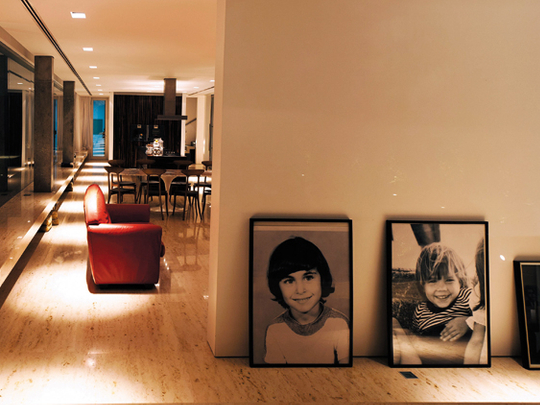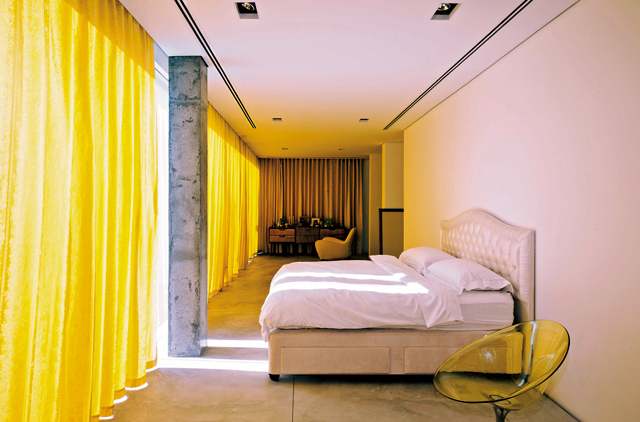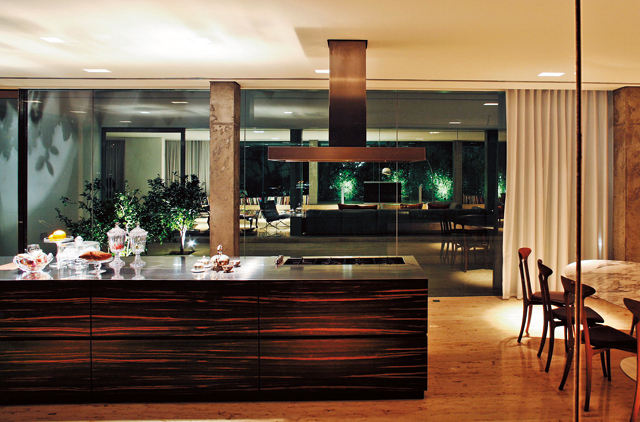
Architect Khalid Al Najjar's style of contemporary, spatial architecture is well-honed and his company, dxb.lab's projects could easily sit on a par with international award-winning designers in that genre. Yet, rather than make a splash with the tallest tower or a seven-star hotel, this Emirati talent is quietly introducing his post-modern concepts to the older areas of Dubai, where his architecture makes a real difference to its surroundings.
A lover of films and film-making - Khalid is a huge fan of Stanley Kubrick's and David Lynch's work - this has influenced the design concept of his own home, which he describes as "a filmic experience". His home is also a perfect illustration of his creative thought process. Constructed over a 15,000-square-foot piece of land in the residential section of Barsha, from the outside, the house looks no more than a square, unassuming structure nestled in a typical, organically developed neighbourhood of Dubai.
Click here to see more pictures of this home
'Floating kingdoms' of the ocean
An elegant and playful Palm Beach home
A tour of an Arabian Ranches garden
"The house is like a fortress from the outside," Khalid says, "but once you are within the walls, it is totally open with a flow of inside and outside spaces. The design is very similar to domestic, Arabian architecture, where the elements are turned inwards, creating a micro-environment for the people living there, but not for outsiders to see."
It took six years and multiple variations of the design before Khalid decided to start construction. "My wife and I were in no hurry," he says. "We were initially living in the family home and then later in an apartment." He found a rookie contractor - one of the few willing to take on a regular home project in the midst of Dubai's construction boom - and carefully managed him, giving detailed instructions each step of the way.
After 18 months of work, the simple yet sophisticated rectangular structure was complete, its glass facade appearing to float atop a large slab of stone. Large, frameless glass panels allow views from the pool end, past the various living spaces, through to the garden at the other end. "The whole house is a stage for home-life, in the sense that if you sit at one end, you can see various actions of domestic living framed in layered sequences of clear glass," says Khalid.
"I love film-making - the technique of creating a montage - and this influenced my work greatly. I also love collecting cameras." He points to a 1954 Leica, which is the same model held by Stanley Kubrick in his famous self-portrait. Next to the camera lies a collection of spectacles. He owns more than 150 vintage, bespoke and hand-crafted frames gathered over years of travel. "My third weakness is furniture," he admits.
The couple are obvious aesthetes and their home is dotted with classic or statement pieces. A Mies Van Der Rohe chair designed for Knoll sits in the living area next to a Vitra classic by Charles Eames. One-off, Italian-crafted vintage pieces can be found in various nooks, while a carved, wooden table from Khalid's father's travels to the Far East in the 1970s creates an interesting dichotomy of contemporary and exotic, yet sits as a comfortable and familiar object filled with memories.
Despite the couple's love of collectables, their home is devoid of clutter - but, surprisingly, Khalid and his wife are not fans of minimalism. "We believe that a home should be decorated slowly over the years - not quickly filled in - with pieces that you cherish, that you treasure, and that hold fond memories."
The floor plan of the home runs in a rectangular loop with the courtyard in the middle. There are no doors obstructing the layout; just a smooth transition into the different spaces. The rectangular stone base that the home ‘sits' on was bought from a quarry in a Munich suburb, and has little fossils punctuating the cream colour. This stone constitutes the flooring for the entire ground floor and runs from the entrance corridor through the living and dining areas, out onto the terrace and courtyard. The layout upstairs is in a similar loop with one side of the house dedicated to the master suite that overlooks the pool. The area is not enclosed and the spaces flow uninterrupted via corridors to the children's bedrooms on the other side.
"The ground floor is what I call the bright zone," says Khalid. "It is flooded with light, and is the social, communal space where we interact. Upstairs is the quiet zone where we sleep."
As soon as you enter the dining section of the ground floor, your eye travels straight to a striking ebony wood kitchen that holds centre stage. "Part of domestic theatrics is cooking, where the act or process is a communal thing." It's clear that the kitchen is a fundamental part of this home and so has pride of place. "My wife and I love to cook. We rarely go out, and so the house was designed as such. It is a kitchen that is used and abused, and not just an expensive and pretty show piece."
The dining area opens on to a serene courtyard containing a pool and a huge, ‘floating' wall. "When the wind hits that wall, the air funnels underneath and makes the pool cooler. At the same time, the wall acts as a privacy device, a shield for the completely glass facade of the master bedroom upstairs." Throughout the day, natural light plays with the architecture, forming interesting light and dark shadows around the pool. At night, the addition of man-made lights increases the dramatic effect considerably. To heighten this ambience, Khalid occasionally projects a movie or mood-based moving imagery, such as falling rain, from his bedroom onto the wall, as a backdrop whilst swimming or lounging by the pool. The effect is stunning and as Khalid would say, truly "theatrical".











